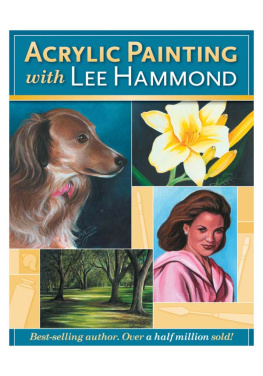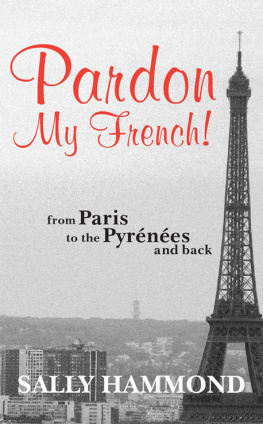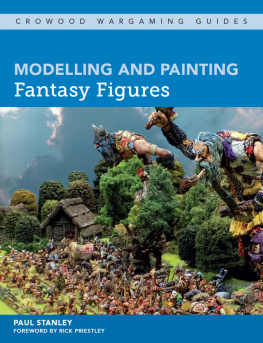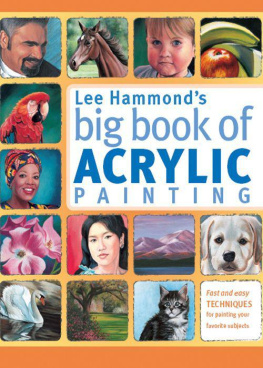Acrylic Painting with Lee Hammond
North Light Books
www.artistsnetwork.com
Foreword
Lee Hammond painting in her studio in Overland Park, Kansas.
There are many books about the many ways one can create a work of art. But what makes each painting different? If we all painted the same way or viewed things in the same fashion, we would need only one book to learn from. But life isnt that simple, thank goodness! The reason we have so many books to choose from is that each of us is unique. For that reason, especially in art, there is clearly no real right or wrong wayjust many different and wonderful approaches. As creative people, we can experiment and choose the techniques that fit our personal styles.
This book is all about my technique for painting with acrylics. I will never say that it is the right way or the only way to paint. If you have never painted with acrylics before, this book will be a good introduction to the medium. As you paint the projects in this book, you may find that my approach feels natural to you, or you may discover your own way of painting. Have fun buying other books on the subject of acrylics (there are many great ones out there) and comparing how each artist tackles the medium. Explore and experiment. Learn from all you do so that you can make your own unique statement with your art. Most of all, relax and enjoy the process, and have a wonderful time with your new adventure!
Introduction
I have been writing art technique books for more than a decade. This book, however, is my first one about painting rather than drawing. Being an art instructor, I pushed myself as I was creating the art for this book, taking note of the differences between my approaches to painting and drawing. I also noticed that I used some of the same thought processes and applications with both. When I create my books, I often use the illustrations as examples in my art classes. I allow my students to ask questions while they watch me work, and I use their questions to guide me as I write.
As my students watched me paint, we all came to a powerful conclusion. It is very important to learn to draw well if you want to paint well. Many painters do not have a solid drawing background, and it often shows. Those who do produce paintings with accurate perspective and good dimensional form.
This book is a collection of colorful projects designed to help you learn to paint with acrylics. The more than 25 step-by-step projects will also give you a wide range of subject matter to enjoy. Some of the projects may look complex, but remember that painting with acrylic is all about painting in layers. Since acrylics dry rapidly, it is easy to keep adding details or to cover up previous applications a little at a time. Youre never stuck when you work with acrylic paint; it is a very forgiving medium.
It is also important to remember that every painting goes through what I call the awkward stage. The initial layers of a painting, when you are essentially creating a color map to follow, will be sloppy, and the watered-down pigments will look weak. Dont become discouraged and stop too soon! By adding more layers and details with thicker paint, youll achieve the realistic look youre after.
This is an example of what you can do if you keep practicing. If you look closely, you will see places where colors are placed on top of other colors. After you have painted some of the projects in this book, you may want to come back to this painting and try to paint it yourself.
BOWL OF FRUIT
9 12 (23cm 30cm)
This example shows the typical stopping point for most beginning acrylic painters. The paint looks watercolor-like, the colors look weak and the canvas shows through. However, this painting looks unfinished because it is. This important awkward stage is merely a color map for the more detailed layers to come.
This painting looks much more professional. Thicker, undiluted paint and layered details create a realistic look. The canvas now is totally covered, and the colors are much more vibrant. Everything comes together in the final stages of the painting. The effort is definitely worth it!
TIGER SWALLOWTAIL ON A BUTTERFLY BUSH
16 12 (41cm 30cm)
CHAPTER 1
Getting Started
PAINTS, TOOLS AND SUPPLIES
You dont need a room full of supplies to begin painting with acrylics. I use a very small number of colors on my palette and only a few different brushes. Keeping it simple makes me feel more relaxed in my work area.
A tackle box is a great place to keep your painting supplies. Its easy to carry with you when you want to paint on location, and it acts as a storage unit when youre not painting. Have fun creating your own custom acrylic painting kit! Everything youll need to get started is listed on this page.
Start-Up Kit
Below is a list of essentials you should have on hand to get you started on the painting projects in this book. Happy painting!
Paints: Prussian Blue, Ivory Black, Titanium White, Burnt Umber, Cadmium Yellow Medium, Cadmium Red Medium, Alizarin Crimson.
Surfaces: Prestretched canvases, canvas panels and/or canvas sheets.
Brushes: -inch (19mm) filbert, no. 3 filbert, no. 4 filbert, no. 6 filbert, no. 8 filbert, no. 2 liner, no. 1 liner, no. 2/0 liner, no. 2/0 round, no. 2 round, no. 4 round, no. 6 round, no. 6 flat, no. 4 flat, hake.
Palette: Plastic, with a lid (or improvise your own).
Other Materials: Cloth rags, wet wipes, cans or jars, spray bottle of water, palette knife, masking or drafting tape, mechanical pencil with 2B lead, ruler, kneaded eraser.
Paints, Tools and Supplies
A simple set of tools and a limited palette of colors are all you need to start painting in acrylics. A tackle box makes a great storage unit.
What Is Acrylic Paint?
Acrylic paints are made of dry pigment in a liquid polymer binder, which is a form of acrylic plastic. Acrylics are water-based, so they require no paint thinners as oil paints do, though they can be diluted with water while painting.
Acrylic paint dries quickly to a waterproof finish. Because of its plastic, waterproof quality, it can be used on a variety of surfaces. It is a favorite for painting on windows, outdoor signs, walls and fabric. It is permanent, so items painted with it are washable.




















